A Macroscopic Exploration of the Ideoscape on Exosomes for Bone Regeneration
Abstract
1. Introduction
2. Materials and Methods
“Exosome*”[MeSH] OR “Exosome*”[Title/Abstract] OR “Extracellular Vesicle*”[Title/Abstract] OR “Microvesicle*”[Title/Abstract]) AND (“Tissue Regeneration”[Title/Abstract] OR “Regenerative Medicine”[MeSH] OR “Regenerative Medicine”[Title/Abstract] OR “Tissue Repair”[Title/Abstract] OR “Regenerative Therapy”[Title/Abstract] OR “Wound Healing”[MeSH]
I have a topic that contains the following documents:
[DOCUMENTS]
The topic is described by the following keywords: [KEYWORDS]
Based on the information above, extract a short but highly descriptive topic label of at most five words. Make sure it is in the following format:
topic: <topic label>
You are an expert in extracting key concepts, keywords, and relationships from scientific text to create a knowledge graph.
Please extract the key concepts and their relationships from the following text. Make sure to provide meaningful labels and categories for each concept and normalize similar keywords to the same form. Use a concise and clear format.
Here’s the text:
\n\n{text}\n\n
Return the result in JSON format with ‘nodes’ and ‘relationships’ keys.
3. Results and Discussion
3.1. Overview of the Dataset
3.2. Exosomes for Bone Regeneration
“Mesenchymal stem cell-derived exosomes as a promising cell-free therapy for knee osteoarthritis.”[60]
“Exosomes Reshape the Osteoarthritic Defect: Emerging Potential in Regenerative Medicine-A Review.”[61]
“Exosomes Derived from Bone Marrow Mesenchymal Stem Cells Alleviate Rheumatoid Arthritis Symptoms via Shuttling Proteins.”[62]
“Exosomes derived from MSC as drug system in osteoarthritis therapy.”[63]
“Proteomic analysis of exosomal proteins associated with bone healing speed in a rat tibial fracture model.”[64]
“Cellular and Molecular Connections Between Bone Fracture Healing and Exosomes.”[65]
“Role of nano-hydrogels coated exosomes in bone tissue repair.”[66]
“Enhancing bone regeneration and immunomodulation via gelatin methacryloyl hydrogel-encapsulated exosomes from osteogenic pre-differentiated mesenchymal stem cells.”[67]
“Clinical Efficacy of Extracellular Vesicle Therapy in Periodontitis: Reduced Inflammation and Enhanced Regeneration.”[68]
“3D bioprinted small extracellular vesicles from periodontal cells enhance mesenchymal stromal cell function.”[69]
“Effects of periodontal cells-derived extracellular vesicles on mesenchymal stromal cell function.”[70]
“Exosomes as Promising Therapeutic Tools for Regenerative Endodontic Therapy.”[71]
“Human dental pulp stem cell-derived exosomes decorated titanium scaffolds for promoting bone regeneration.”[72]
“Exosomes derived from odontogenic stem cells: Its role in the dentin-pulp complex.”[73]
“Functionalized 3D Hydroxyapatite Scaffold by Fusion Peptides-Mediated Small Extracellular Vesicles of Stem Cells for Bone Tissue Regeneration.”[74]
“Transplanted MSCs promote alveolar bone repair via hypoxia-induced extracellular vesicle secretion.”[75]
“Bioengineering extracellular vesicles: smart nanomaterials for bone regeneration.”[76]
“Biomimetic synthesis and optimization of extracellular vesicles for bone regeneration.”[77]
“Nanoscale Treatment of Intervertebral Disc Degeneration: Mesenchymal Stem Cell Exosome Transplantation.”[78]
“MSC-Derived Exosomes Ameliorate Intervertebral Disc Degeneration By Regulating the Keap1/Nrf2 Axis.”[79]
“Exosomes: A promising therapeutic strategy for intervertebral disc degeneration.”[80]
3.3. Evolution of the Field
3.4. Knowledge Structure of Exosome Research: The Ideoscape
4. Conclusions
Supplementary Materials
Author Contributions
Funding
Data Availability Statement
Conflicts of Interest
References
- Lange, M.; Babczyk, P.; Tobiasch, E. Exosomes: A New Hope for Angiogenesis-Mediated Bone Regeneration. Int. J. Mol. Sci. 2024, 25, 5204. [Google Scholar] [CrossRef]
- Théry, C.; Amigorena, S.; Raposo, G.; Clayton, A. Isolation and Characterization of Exosomes from Cell Culture Supernatants and Biological Fluids. Curr. Protoc. Cell Biol. 2006, 30, 3–22. [Google Scholar] [CrossRef] [PubMed]
- Welsh, J.A.; Goberdhan, D.C.I.; O’Driscoll, L.; Buzas, E.I.; Blenkiron, C.; Bussolati, B.; Cai, H.; Di Vizio, D.; Driedonks, T.A.P.; Erdbrügger, U. Minimal Information for Studies of Extracellular Vesicles (MISEV2023): From Basic to Advanced Approaches. J. Extracell. Vesicles 2024, 13, e12404. [Google Scholar] [CrossRef] [PubMed]
- Kalluri, R.; LeBleu, V.S. The Biology, Function, and Biomedical Applications of Exosomes. Science 2020, 367, eaau6977. [Google Scholar] [CrossRef] [PubMed]
- Mathieu, M.; Martin-Jaular, L.; Lavieu, G.; Théry, C. Specificities of Secretion and Uptake of Exosomes and Other Extracellular Vesicles for Cell-to-Cell Communication. Nat. Cell Biol. 2019, 21, 9–17. [Google Scholar] [CrossRef] [PubMed]
- Harrell, C.R.; Jovicic, N.; Djonov, V.; Volarevic, V. Therapeutic Use of Mesenchymal Stem Cell-Derived Exosomes: From Basic Science to Clinics. Pharmaceutics 2020, 12, 474. [Google Scholar] [CrossRef]
- Kučuk, N.; Primožič, M.; Knez, Ž.; Leitgeb, M. Exosomes Engineering and Their Roles as Therapy Delivery Tools, Therapeutic Targets, and Biomarkers. Int. J. Mol. Sci. 2021, 22, 9543. [Google Scholar] [CrossRef]
- Mukherjee, A.; Bisht, B.; Dutta, S.; Paul, M.K. Current Advances in the Use of Exosomes, Liposomes, and Bioengineered Hybrid Nanovesicles in Cancer Detection and Therapy. Acta Pharmacol. Sin. 2022, 43, 2759–2776. [Google Scholar] [CrossRef]
- Arya, S.B.; Collie, S.P.; Parent, C.A. The Ins-and-Outs of Exosome Biogenesis, Secretion, and Internalization. Trends Cell Biol. 2024, 34, 90–108. [Google Scholar] [CrossRef]
- Xue, N.; Ding, X.; Huang, R.; Jiang, R.; Huang, H.; Pan, X.; Min, W.; Chen, J.; Duan, J.-A.; Liu, P. Bone Tissue Engineering in the Treatment of Bone Defects. Pharmaceuticals 2022, 15, 879. [Google Scholar] [CrossRef]
- Egido-Moreno, S.; Valls-Roca-Umbert, J.; Céspedes-Sánchez, J.M.; López-López, J.; Velasco-Ortega, E. Clinical Efficacy of Mesenchymal Stem Cells in Bone Regeneration in Oral Implantology. Systematic Review and Meta-Analysis. Int. J. Environ. Res. Public Health 2021, 18, 894. [Google Scholar] [CrossRef] [PubMed]
- Wang, X.; Thomsen, P. Mesenchymal Stem Cell–Derived Small Extracellular Vesicles and Bone Regeneration. Basic. Clin. Pharmacol. Toxicol. 2021, 128, 18–36. [Google Scholar] [CrossRef] [PubMed]
- Torrecillas-Baena, B.; Pulido-Escribano, V.; Dorado, G.; Gálvez-Moreno, M.Á.; Camacho-Cardenosa, M.; Casado-Díaz, A. Clinical Potential of Mesenchymal Stem Cell-Derived Exosomes in Bone Regeneration. J. Clin. Med. 2023, 12, 4385. [Google Scholar] [CrossRef] [PubMed]
- Tan, S.H.S.; Wong, J.R.Y.; Sim, S.J.Y.; Tjio, C.K.E.; Wong, K.L.; Chew, J.R.J.; Hui, J.H.P.; Toh, W.S. Mesenchymal Stem Cell Exosomes in Bone Regenerative Strategies—A Systematic Review of Preclinical Studies. Mater. Today Bio 2020, 7, 100067. [Google Scholar] [CrossRef]
- Irfan, D.; Ahmad, I.; Patra, I.; Margiana, R.; Rasulova, M.T.; Sivaraman, R.; Kandeel, M.; Mohammad, H.J.; Al-Qaim, Z.H.; Jawad, M.A.; et al. Stem Cell-Derived Exosomes in Bone Healing: Focusing on Their Role in Angiogenesis. Cytotherapy 2023, 25, 353–361. [Google Scholar] [CrossRef]
- Meng, F.; Xue, X.; Yin, Z.; Gao, F.; Wang, X.; Geng, Z. Research Progress of Exosomes in Bone Diseases: Mechanism, Diagnosis and Therapy. Front. Bioeng. Biotechnol. 2022, 10, 866627. [Google Scholar] [CrossRef]
- De Rosnay, J. Le Macroscope. Vers Une Vision Globale; Média Diffusion: Paris, France, 2014; ISBN 202118644X. [Google Scholar]
- Appadurai, A. Modernity at Large: Cultural Dimensions of Globalization; U of Minnesota Press: Minneapolis, MN, USA, 1996; Volume 1, ISBN 145290006X. [Google Scholar]
- Kherwa, P.; Bansal, P. Topic Modeling: A Comprehensive Review. ICST Trans. Scalable Inf. Syst. 2018, 159623. [Google Scholar] [CrossRef]
- Grootendorst, M. BERTopic: Neural Topic Modeling with a Class-Based TF-IDF Procedure. arXiv 2022, arXiv:2203.05794. [Google Scholar]
- Churchill, R.; Singh, L. The Evolution of Topic Modeling. ACM Comput. Surv. 2022, 54, 1–35. [Google Scholar] [CrossRef]
- Liu, Q.; Kusner, M.J.; Blunsom, P. A Survey on Contextual Embeddings. arXiv 2020, arXiv:2003.07278. [Google Scholar]
- Wang, Z.; Chen, J.; Chen, J.; Chen, H. Identifying Interdisciplinary Topics and Their Evolution Based on BERTopic. Scientometrics 2023, 1–26. [Google Scholar] [CrossRef]
- Börner, K.; Record, E. Macroscopes for Making Sense of Science. In Proceedings of the Practice and Experience in Advanced Research Computing 2017 on Sustainability, Success and Impact, New Orleans, LA, USA, 9–13 July 2017; pp. 1–2. [Google Scholar]
- Bassi, S. A Primer on Python for Life Science Researchers. PLoS Comput. Biol. 2007, 3, e199. [Google Scholar] [CrossRef] [PubMed]
- Jia, Z.; Maggioni, M.; Smith, J.; Scarpazza, D.P. Dissecting the NVidia Turing T4 GPU via Microbenchmarking. arXiv 2019, arXiv:1903.07486. [Google Scholar]
- Cock, P.J.A.; Antao, T.; Chang, J.T.; Chapman, B.A.; Cox, C.J.; Dalke, A.; Friedberg, I.; Hamelryck, T.; Kauff, F.; Wilczynski, B. Biopython: Freely Available Python Tools for Computational Molecular Biology and Bioinformatics. Bioinformatics 2009, 25, 1422–1423. [Google Scholar] [CrossRef]
- Mckinney, W. Data Structures for Statistical Computing in Python. In Proceedings of the 9th Python in Science Conference, Austin, TX, USA, 28 June–3 July 2010; pp. 51–56. [Google Scholar]
- Gan, L.; Yang, T.; Huang, Y.; Yang, B.; Luo, Y.Y.; Richard, L.W.C.; Guo, D. Experimental Comparison of Three Topic Modeling Methods with LDA, Top2Vec and BERTopic. In Proceedings of the International Symposium on Artificial Intelligence and Robotics, Atlanta, GA, USA, 8–10 July 2010; Springer: Singapore, 2023; pp. 376–391. [Google Scholar]
- Cook, D.A.; Beckman, T.J.; Bordage, G. A Systematic Review of Titles and Abstracts of Experimental Studies in Medical Education: Many Informative Elements Missing. Med. Educ. 2007, 41, 1074–1081. [Google Scholar] [CrossRef]
- Hartley, J. Planning That Title: Practices and Preferences for Titles with Colons in Academic Articles. Libr. Inf. Sci. Res. 2007, 29, 553–568. [Google Scholar] [CrossRef]
- Galli, C.; Donos, N.; Calciolari, E. Performance of 4 Pre-Trained Sentence Transformer Models in the Semantic Query of a Systematic Review Dataset on Peri-Implantitis. Information 2024, 15, 68. [Google Scholar] [CrossRef]
- Guizzardi, S.; Colangelo, M.T.; Mirandola, P.; Galli, C. Modeling New Trends in Bone Regeneration, Using the BERTopic Approach. Regen. Med. 2023, 18, 719–734. [Google Scholar] [CrossRef]
- Saif, H.; Fernandez, M.; He, Y.; Alani, H. On Stopwords, Filtering and Data Sparsity for Sentiment Analysis of Twitter. In Proceedings of the Ninth International Conference on Language Resources and Evaluation (LREC’14), Reykjavik, Iceland, 26–31 May 2014. [Google Scholar]
- Gutiérrez, L.; Keith, B. A Systematic Literature Review on Word Embeddings. In Trends and Applications in Software Engineering, Proceedings of the 7th International Conference on Software Process Improvement (CIMPS 2018), Guadalajara, Mexico, 17–19 October 2018; Springer: Berlin/Heidelberg, Germany, 2019; pp. 132–141. [Google Scholar]
- Jurafsky, D.; Martin, J.H.; Vector Semantics and Embeddings. Speech and Language Processing: An Introduction to Natural Language Processing, Computational Linguistics, and Speech Recognition with Language Models, 3rd ed. Online manuscript released 20 August 2024. Available online: https://web.stanford.edu/~jurafsky/slp3 (accessed on 30 September 2024).
- Wang, S.; Zhou, W.; Jiang, C. A Survey of Word Embeddings Based on Deep Learning. Computing 2020, 102, 717–740. [Google Scholar] [CrossRef]
- Vaswani, A.; Shazeer, N.; Parmar, N.; Uszkoreit, J.; Jones, L.; Gomez, A.N.; Kaiser, Ł.; Polosukhin, I. Attention Is All You Need. Adv. Neural Inf. Process Syst. 2017, 30, 6000–6010. [Google Scholar]
- Qaiser, S.; Ali, R. Text Mining: Use of TF-IDF to Examine the Relevance of Words to Documents. Int. J. Comput. Appl. 2018, 181, 25–29. [Google Scholar] [CrossRef]
- Xu, D.D.; Wu, S.B. An Improved TFIDF Algorithm in Text Classification. Appl. Mech. Mater. 2014, 651, 2258–2261. [Google Scholar] [CrossRef]
- McInnes, L.; Healy, J.; Melville, J. Umap: Uniform Manifold Approximation and Projection for Dimension Reduction. arXiv 2018, arXiv:1802.03426. [Google Scholar]
- McInnes, L.; Healy, J.; Astels, S. Hdbscan: Hierarchical Density Based Clustering. J. Open Source Softw. 2017, 2, 205. [Google Scholar] [CrossRef]
- Haider, M.M.; Hossin, M.A.; Mahi, H.R.; Arif, H. Automatic Text Summarization Using Gensim Word2vec and K-Means Clustering Algorithm. In Proceedings of the 2020 IEEE Region 10 Symposium (TENSYMP), Dhaka, Bangladesh, 5–7 June 2020; IEEE: Piscataway, NJ, USA, 2020; pp. 283–286. [Google Scholar]
- Issa, B.; Jasser, M.B.; Chua, H.N.; Hamzah, M. A Comparative Study on Embedding Models for Keyword Extraction Using KeyBERT Method. In Proceedings of the 2023 IEEE 13th International Conference on System Engineering and Technology (ICSET), Shah Alam, Malaysia, 2 October 2023; IEEE: Piscataway, NJ, USA, 2023; pp. 40–45. [Google Scholar]
- Zhang, Y.; Jin, R.; Zhou, Z.-H. Understanding Bag-of-Words Model: A Statistical Framework. Int. J. Mach. Learn. Cybern. 2010, 1, 43–52. [Google Scholar] [CrossRef]
- Bennani-Smires, K.; Musat, C.; Hossmann, A.; Baeriswyl, M.; Jaggi, M. Simple Unsupervised Keyphrase Extraction Using Sentence Embeddings. arXiv 2018, arXiv:1801.04470. [Google Scholar]
- Thirunavukarasu, A.J.; Ting, D.S.J.; Elangovan, K.; Gutierrez, L.; Tan, T.F.; Ting, D.S.W. Large Language Models in Medicine. Nat. Med. 2023, 29, 1930–1940. [Google Scholar] [CrossRef]
- Akre, P.; Malu, R.; Jha, A.; Tekade, Y.; Bisen, W. Sentiment Analysis Using Opinion Mining on Customer Review. Int. J. Eng. Manag. Res. 2023, 13, 41–44. [Google Scholar]
- Hunter, J.D. Matplotlib: A 2D Graphics Environment. Comput. Sci. Eng. 2007, 9, 90–95. [Google Scholar] [CrossRef]
- Waskom, M. Seaborn: Statistical Data Visualization. J. Open Source Softw. 2021, 6, 3021. [Google Scholar] [CrossRef]
- McInnes, L. DataMapPlot. Available online: https://github.com/TutteInstitute/datamapplot (accessed on 10 March 2024).
- Virtanen, P.; Gommers, R.; Oliphant, T.E.; Haberland, M.; Reddy, T.; Cournapeau, D.; Burovski, E.; Peterson, P.; Weckesser, W.; Bright, J. SciPy 1.0: Fundamental Algorithms for Scientific Computing in Python. Nat. Methods 2020, 17, 261–272. [Google Scholar] [CrossRef] [PubMed]
- Ji, S.; Pan, S.; Cambria, E.; Marttinen, P.; Yu, P.S. A Survey on Knowledge Graphs: Representation, Acquisition, and Applications. IEEE Trans. Neural Netw. Learn. Syst. 2022, 33, 494–514. [Google Scholar] [CrossRef] [PubMed]
- Honnibal, M.; Montani, I. SpaCy 2: Natural Language Understanding with Bloom Embeddings, Convolutional Neural Networks and Incremental Parsing. To Appear 2017, 7, 411–420. [Google Scholar]
- Miller, J.J. Graph Database Applications and Concepts with Neo4j. In Proceedings of the Southern Association for Information Systems Conference, Atlanta, GA, USA, 15–17 August 2013; Volume 2324, pp. 141–147. [Google Scholar]
- Chen, X.; Yang, N.; Li, B.; Gao, X.; Wang, Y.; Wang, Q.; Liu, X.; Zhang, Z.; Zhang, R. Visualization Analysis of Small Extracellular Vesicles in the Application of Bone-Related Diseases. Cells 2024, 13, 904. [Google Scholar] [CrossRef]
- Sarker, I.H. LLM Potentiality and Awareness: A Position Paper from the Perspective of Trustworthy and Responsible AI Modeling. Discov. Artif. Intell. 2024, 4, 40. [Google Scholar] [CrossRef]
- Rizzo, M.G.; Cai, N.; Constantinescu, D. The Performance of ChatGPT on Orthopaedic In-Service Training Exams: A Comparative Study of the GPT-3.5 Turbo and GPT-4 Models in Orthopaedic Education. J. Orthop. 2024, 50, 70–75. [Google Scholar] [CrossRef]
- Galli, C.; Cusano, C.; Meleti, M.; Donos, N. Topic Modeling for Faster Literature Screening Using Transformer-Based Embeddings. Preprints 2024, 2024072198. [Google Scholar] [CrossRef]
- Luo, D.; Zhu, H.; Li, S.; Wang, Z.; Xiao, J. Mesenchymal Stem Cell-Derived Exosomes as a Promising Cell-Free Therapy for Knee Osteoarthritis. Front. Bioeng. Biotechnol. 2024, 12, 1309946. [Google Scholar] [CrossRef]
- Sankaranarayanan, J.; Lee, S.C.; Kim, H.K.; Kang, J.Y.; Kuppa, S.S.; Seon, J.K. Exosomes Reshape the Osteoarthritic Defect: Emerging Potential in Regenerative Medicine—A Review. Int. J. Stem Cells 2024. [Google Scholar] [CrossRef]
- Wang, L.; Li, F.; Wang, L.; Wu, B.; Du, M.; Xing, H.; Pan, S. Exosomes Derived from Bone Marrow Mesenchymal Stem Cells Alleviate Rheumatoid Arthritis Symptoms via Shuttling Proteins. J. Proteome Res. 2024, 23, 1298–1312. [Google Scholar] [CrossRef]
- Wen, S.; Huang, X.; Ma, J.; Zhao, G.; Ma, T.; Chen, K.; Huang, G.; Chen, J.; Shi, J.; Wang, S. Exosomes Derived from MSC as Drug System in Osteoarthritis Therapy. Front. Bioeng. Biotechnol. 2024, 12, 1331218. [Google Scholar] [CrossRef] [PubMed]
- Hong, H.; Lin, C.; Fang, M.; Liu, J.; Hsu, H.-C.; Chang, C.-J.; Wang, H. Proteomic Analysis of Exosomal Proteins Associated with Bone Healing Speed in a Rat Tibial Fracture Model. Biomed. Chromatogr. 2024, 38, e5846. [Google Scholar] [CrossRef] [PubMed]
- Lv, S.; Wang, G.; Dai, L.; Wang, T.; Wang, F. Cellular and Molecular Connections Between Bone Fracture Healing and Exosomes. Physiol. Res. 2023, 72, 565–574. [Google Scholar] [CrossRef] [PubMed]
- Pan, Y.; Li, Y.; Dong, W.; Jiang, B.; Yu, Y.; Chen, Y. Role of Nano-Hydrogels Coated Exosomes in Bone Tissue Repair. Front. Bioeng. Biotechnol. 2023, 11, 1167012. [Google Scholar] [CrossRef]
- Li, X.; Si, Y.; Liang, J.; Li, M.; Wang, Z.; Qin, Y.; Sun, L. Enhancing Bone Regeneration and Immunomodulation via Gelatin Methacryloyl Hydrogel-Encapsulated Exosomes from Osteogenic Pre-Differentiated Mesenchymal Stem Cells. J. Colloid Interface Sci. 2024, 672, 179–199. [Google Scholar] [CrossRef]
- Puletic, M.; Velikic, G.; Maric, D.M.; Supic, G.; Maric, D.L.; Radovic, N.; Avramov, S.; Vojvodic, D. Clinical Efficacy of Extracellular Vesicle Therapy in Periodontitis: Reduced Inflammation and Enhanced Regeneration. Int. J. Mol. Sci. 2024, 25, 5753. [Google Scholar] [CrossRef] [PubMed]
- Han, P.; Raveendran, N.; Liu, C.; Basu, S.; Jiao, K.; Johnson, N.; Moran, C.S.; Ivanovski, S. 3D Bioprinted Small Extracellular Vesicles from Periodontal Cells Enhance Mesenchymal Stromal Cell Function. Biomater. Adv. 2024, 158, 213770. [Google Scholar] [CrossRef]
- Han, P.; Johnson, N.; Abdal-Hay, A.; Moran, C.S.; Salomon, C.; Ivanovski, S. Effects of Periodontal Cells-Derived Extracellular Vesicles on Mesenchymal Stromal Cell Function. J. Periodontal Res. 2023, 58, 1188–1200. [Google Scholar] [CrossRef]
- Kong, Q.; Wang, Y.; Jiang, N.; Wang, Y.; Wang, R.; Hu, X.; Mao, J.; Shi, X. Exosomes as Promising Therapeutic Tools for Regenerative Endodontic Therapy. Biomolecules 2024, 14, 330. [Google Scholar] [CrossRef]
- Zhang, S.; Wang, S.; Chen, J.; Cui, Y.; Lu, X.; Xiong, S.; Yue, C.; Yang, B. Human Dental Pulp Stem Cell-Derived Exosomes Decorated Titanium Scaffolds for Promoting Bone Regeneration. Colloids Surf. B Biointerfaces 2024, 235, 113775. [Google Scholar] [CrossRef]
- Zou, J.; Xia, H.; Jiang, Q.; Su, Z.; Wen, S.; Liang, Z.; Ouyang, Y.; Liu, J.; Zhang, Z.; Chen, D.; et al. Exosomes Derived from Odontogenic Stem Cells: Its Role in the Dentin-Pulp Complex. Regen. Ther. 2023, 24, 135–146. [Google Scholar] [CrossRef]
- Ma, S.; Ma, B.; Yang, Y.; Mu, Y.; Wei, P.; Yu, X.; Zhao, B.; Zou, Z.; Liu, Z.; Wang, M.; et al. Functionalized 3D Hydroxyapatite Scaffold by Fusion Peptides-Mediated Small Extracellular Vesicles of Stem Cells for Bone Tissue Regeneration. ACS Appl. Mater. Interfaces 2024, 16, 3064–3081. [Google Scholar] [CrossRef]
- Liu, Y.; Zhang, Z.; Ma, C.; Song, J.; Hu, J.; Liu, Y. Transplanted MSCs Promote Alveolar Bone Repair via Hypoxia-Induced Extracellular Vesicle Secretion. Oral Dis. 2024, 1–11. [Google Scholar] [CrossRef] [PubMed]
- Man, K.; Eisenstein, N.M.; Hoey, D.A.; Cox, S.C. Bioengineering Extracellular Vesicles: Smart Nanomaterials for Bone Regeneration. J. Nanobiotechnol. 2023, 21, 137. [Google Scholar] [CrossRef] [PubMed]
- Song, X.; Xu, L.; Zhang, W. Biomimetic Synthesis and Optimization of Extracellular Vesicles for Bone Regeneration. J. Control. Release 2023, 355, 18–41. [Google Scholar] [CrossRef] [PubMed]
- Hu, Y.-C.; Zhang, X.-B.; Lin, M.-Q.; Zhou, H.-Y.; Cong, M.-X.; Chen, X.-Y.; Zhang, R.-H.; Yu, D.-C.; Gao, X.-D.; Guo, T.-W. Nanoscale Treatment of Intervertebral Disc Degeneration: Mesenchymal Stem Cell Exosome Transplantation. Curr. Stem Cell Res. Ther. 2023, 18, 163–173. [Google Scholar] [CrossRef]
- Xu, G.; Lu, X.; Liu, S.; Zhang, Y.; Xu, S.; Ma, X.; Xia, X.; Lu, F.; Zou, F.; Wang, H.; et al. MSC-Derived Exosomes Ameliorate Intervertebral Disc Degeneration By Regulating the Keap1/Nrf2 Axis. Stem Cell Rev. Rep. 2023, 19, 2465–2480. [Google Scholar] [CrossRef]
- Wang, C.; Guo, S.; Gu, Q.; Wang, X.; Long, L.; Xiao, C.; Xie, M.; Shen, H.; Li, S. Exosomes: A Promising Therapeutic Strategy for Intervertebral Disc Degeneration. Exp. Gerontol. 2022, 163, 111806. [Google Scholar] [CrossRef]
- Francis, N.; Green, A.; Guagliardo, P.; Libkin, L.; Lindaaker, T.; Marsault, V.; Plantikow, S.; Rydberg, M.; Selmer, P.; Taylor, A. Cypher: An Evolving Query Language for Property Graphs. In Proceedings of the 2018 International Conference on Management of Data, Kanazawa, Japan, 28 June–2 July 2018; pp. 1433–1445. [Google Scholar]
- Hogan, A.; Blomqvist, E.; Cochez, M.; D’amato, C.; De Melo, G.; Gutierrez, C.; Kirrane, S.; Gayo, J.E.L.; Navigli, R.; Neumaier, S.; et al. Knowledge Graphs. ACM Comput. Surv. 2022, 54, 1–37. [Google Scholar] [CrossRef]
- Peng, C.; Xia, F.; Naseriparsa, M.; Osborne, F. Knowledge Graphs: Opportunities and Challenges. Artif. Intell. Rev. 2023, 56, 13071–13102. [Google Scholar] [CrossRef]
- Wang, T.; Zhou, Y.; Zhang, W.; Xue, Y.; Xiao, Z.; Zhou, Y.; Peng, X. Exosomes and Exosome Composite Scaffolds in Periodontal Tissue Engineering. Front. Bioeng. Biotechnol. 2024, 11, 1287714. [Google Scholar] [CrossRef] [PubMed]
- Trubiani, O.; Pizzicannella, J.; Caputi, S.; Marchisio, M.; Mazzon, E.; Paganelli, R.; Paganelli, A.; Diomede, F. Periodontal Ligament Stem Cells: Current Knowledge and Future Perspectives. Stem Cells Dev. 2019, 28, 995–1003. [Google Scholar] [CrossRef] [PubMed]
- Ju, R.; Gao, X.; Zhang, C.; Tang, W.; Tian, W.; He, M. Exogenous MSCs Based Tissue Regeneration: A Review of Immuno-Protection Strategies from Biomaterial Scaffolds. J. Mater. Chem. B 2024, 36, 8868–8882. [Google Scholar] [CrossRef] [PubMed]
- Zeng, W.-Y.; Ning, Y.; Huang, X. Advanced Technologies in Periodontal Tissue Regeneration Based on Stem Cells: Current Status and Future Perspectives. J. Dent. Sci. 2021, 16, 501–507. [Google Scholar] [CrossRef]
- Isamorad, F.; Ouhestani, F.; Aghandeh, P.; Motamedian, S.R. Application of Periodontal Ligament Stem Cells in Periodontal Regeneration: A Systematic Review. J. Appl. Biotechnol. Rep. 2023, 10, 1055–1068. [Google Scholar]
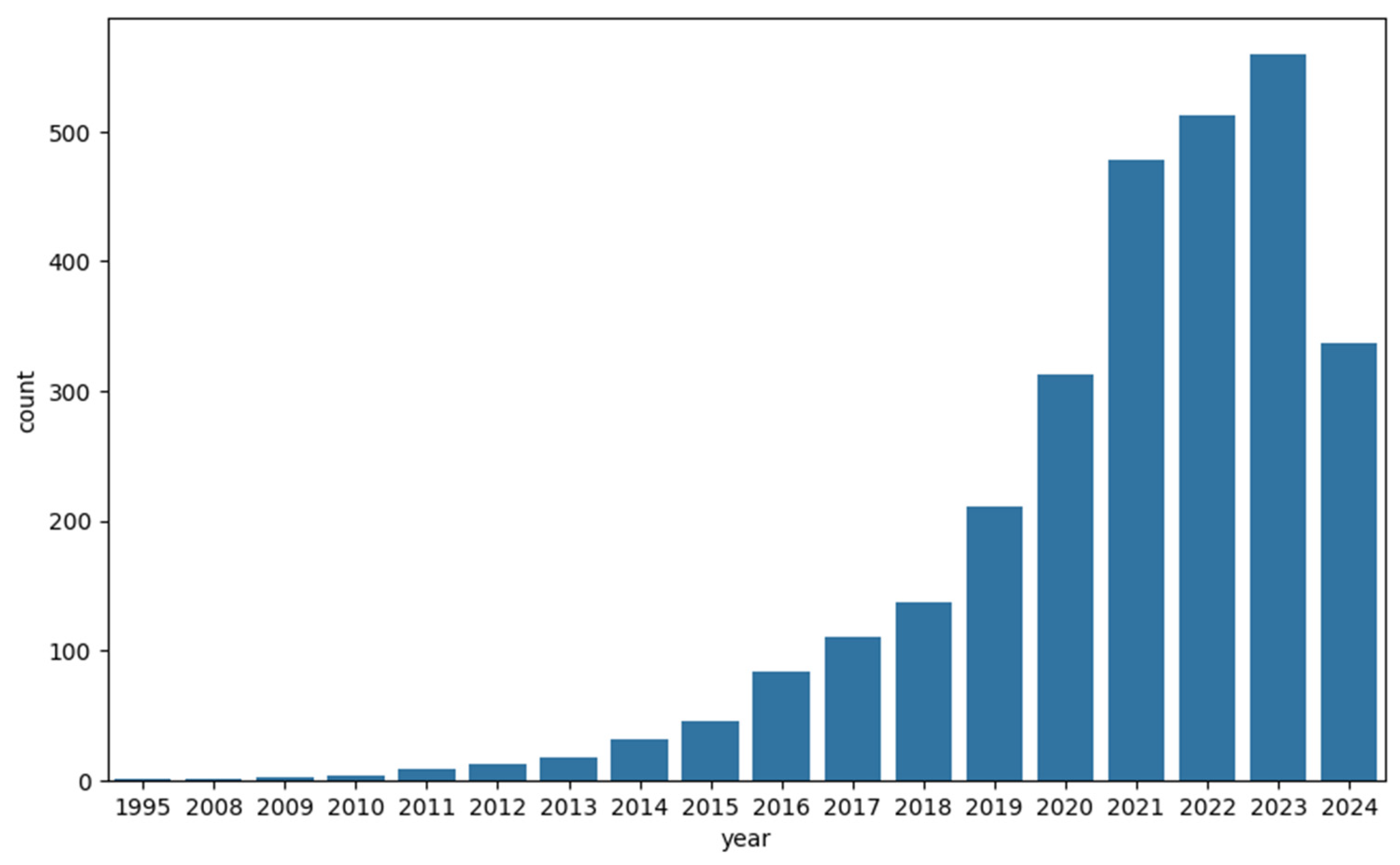


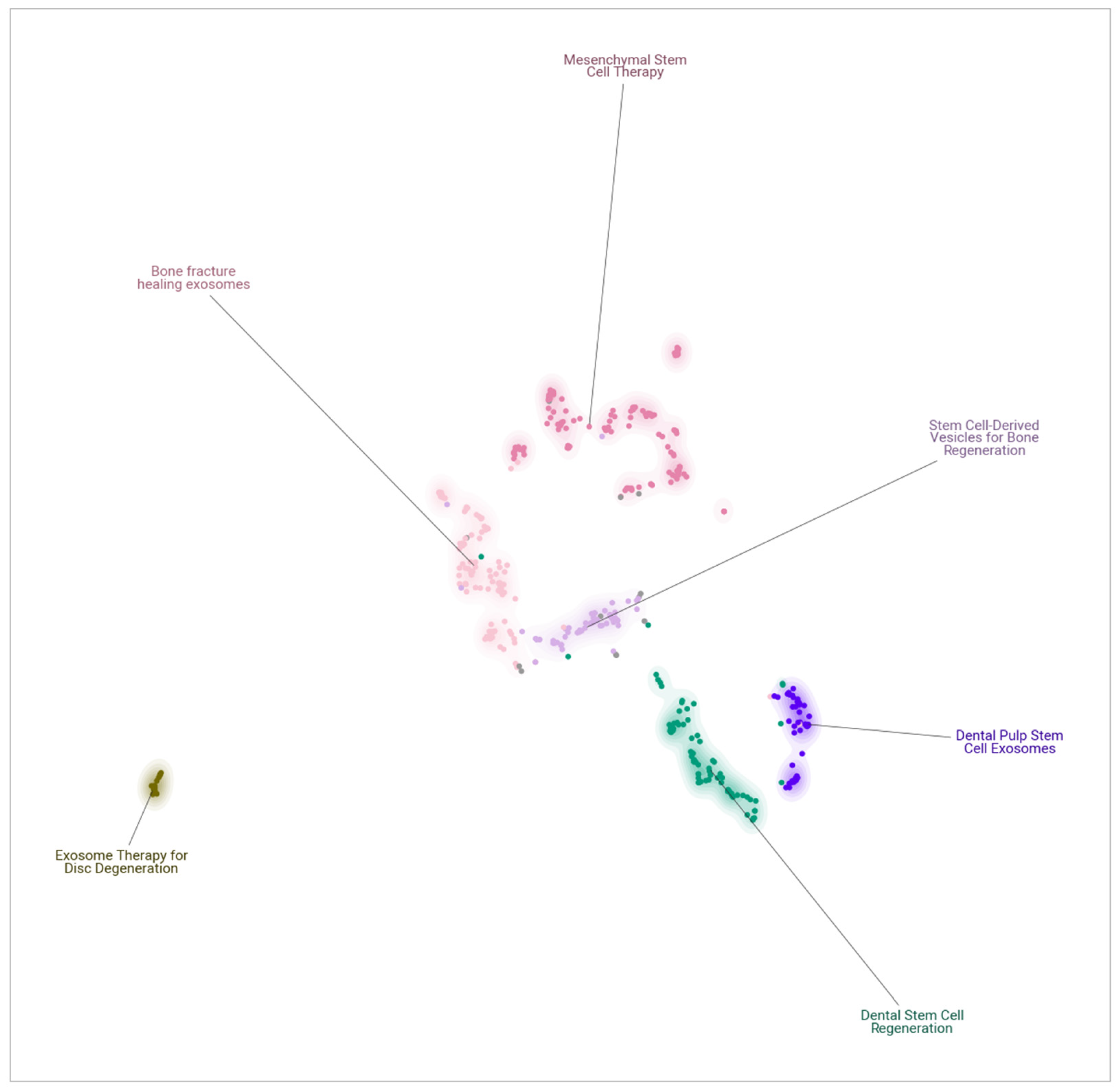


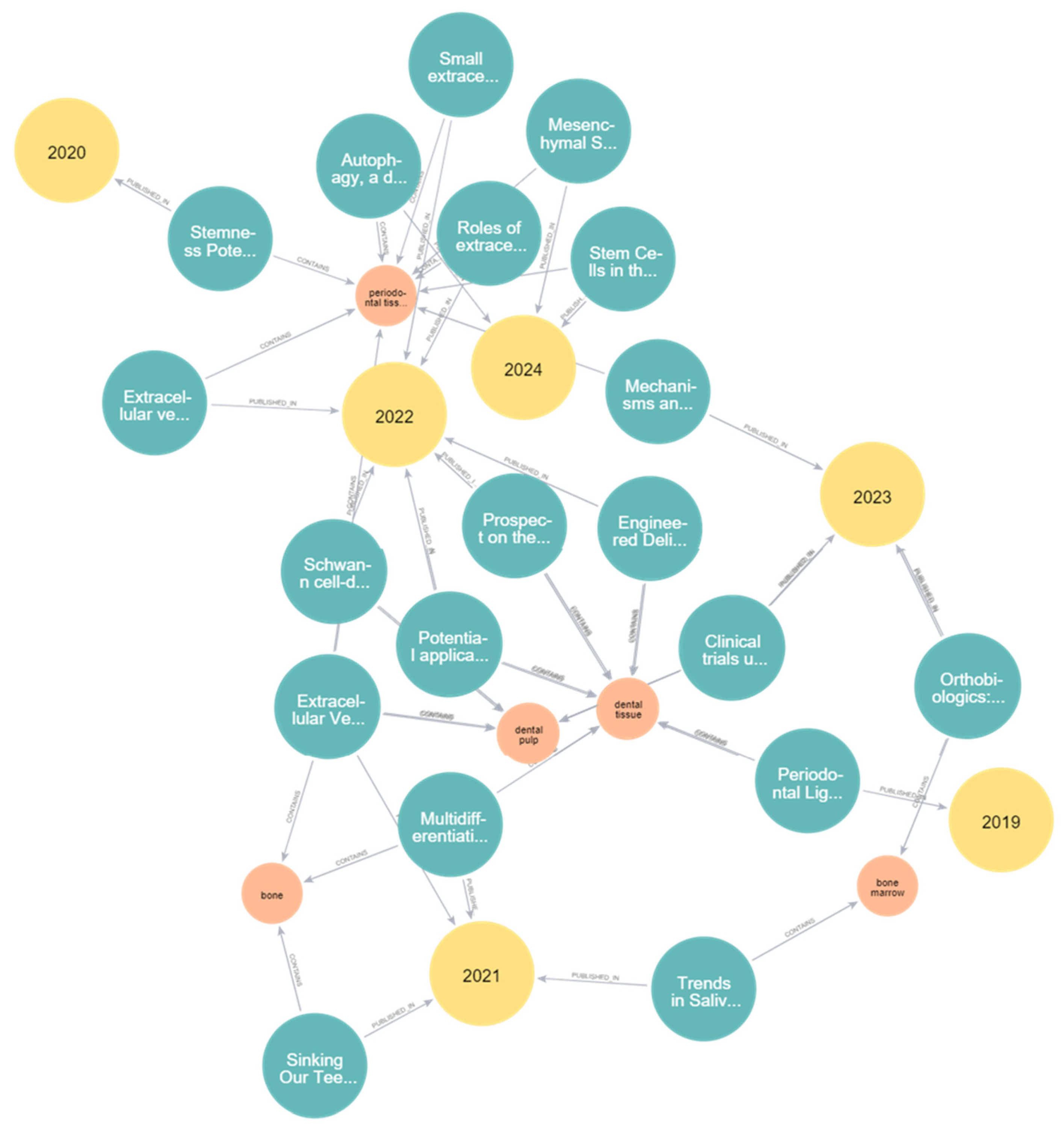
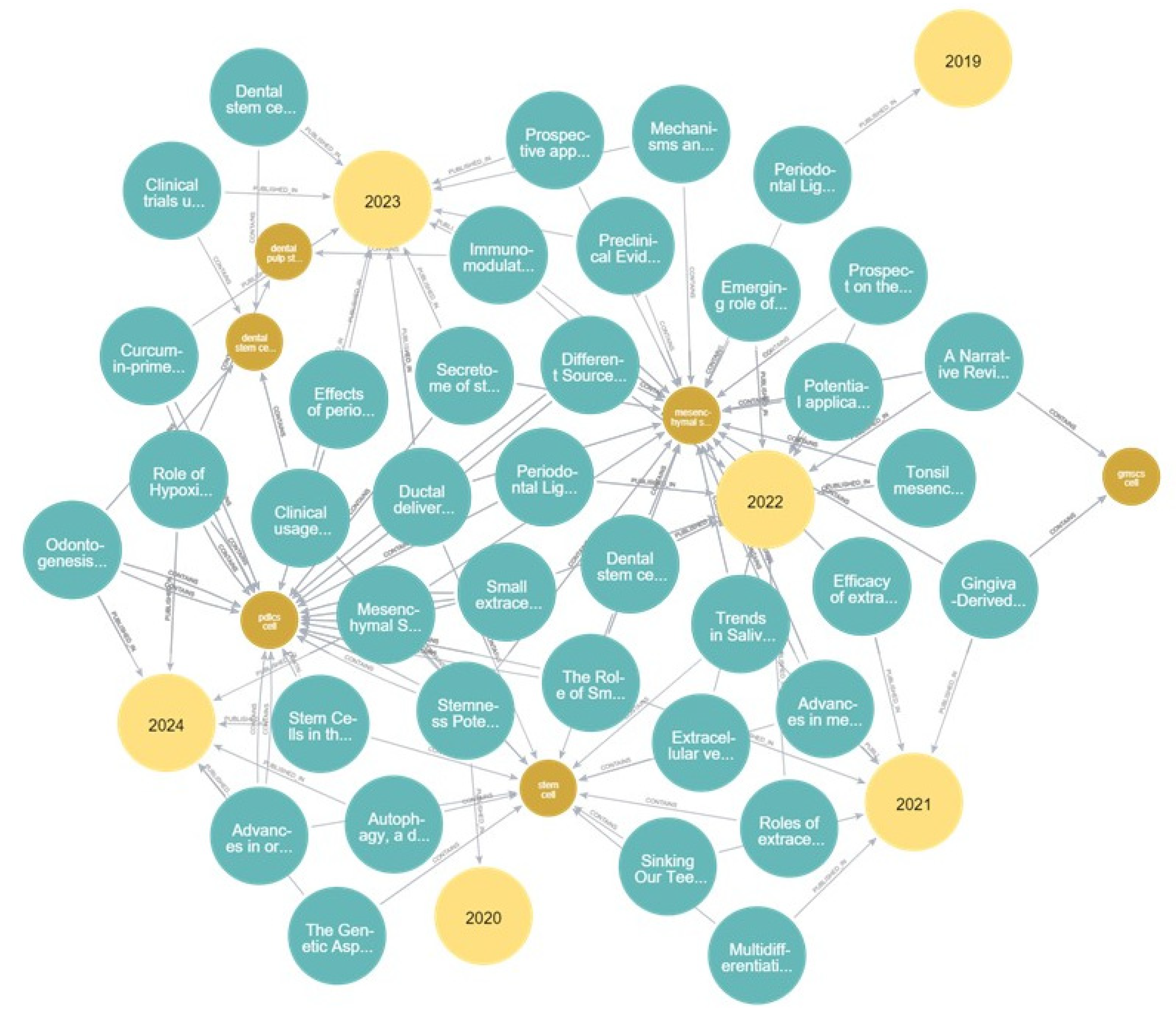

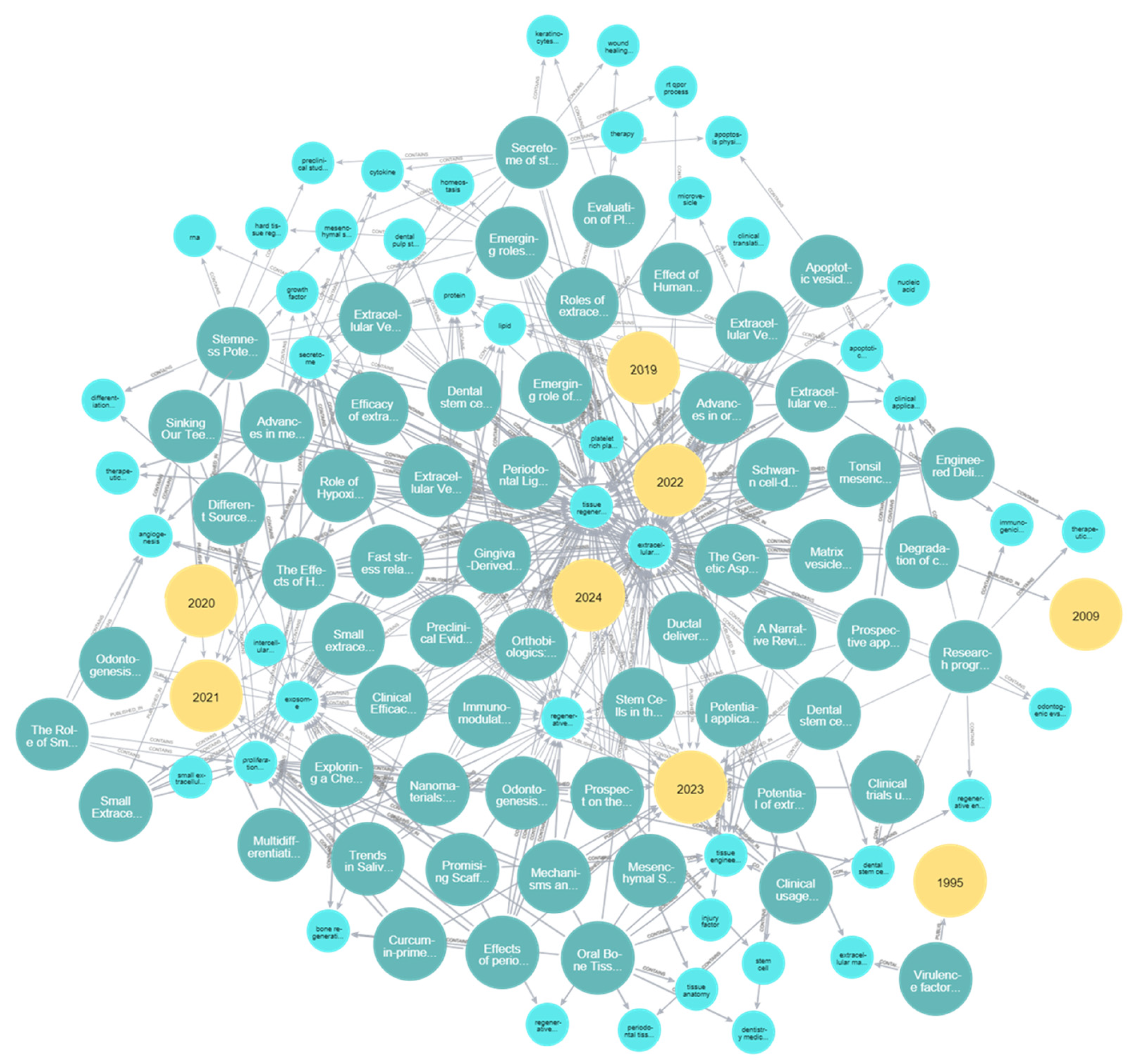
| Topic | Trend (Slope) |
|---|---|
| Dental Stem Cell Regeneration | 4.5 |
| Bone fracture healing exosome | 4.1 |
| Mesenchymal Stem Cell Therapy | 2.4 |
| Dental Pulp Stem Cell Exosomes | 1.8 |
| Exosome Therapy for Disc Degeneration | 1.4 |
| Stem Cell-Derived Vesicles for Bone Regeneration | 1.0 |
Disclaimer/Publisher’s Note: The statements, opinions and data contained in all publications are solely those of the individual author(s) and contributor(s) and not of MDPI and/or the editor(s). MDPI and/or the editor(s) disclaim responsibility for any injury to people or property resulting from any ideas, methods, instructions or products referred to in the content. |
© 2024 by the authors. Licensee MDPI, Basel, Switzerland. This article is an open access article distributed under the terms and conditions of the Creative Commons Attribution (CC BY) license (https://creativecommons.org/licenses/by/4.0/).
Share and Cite
Colangelo, M.T.; Meleti, M.; Guizzardi, S.; Galli, C. A Macroscopic Exploration of the Ideoscape on Exosomes for Bone Regeneration. Osteology 2024, 4, 159-178. https://doi.org/10.3390/osteology4040013
Colangelo MT, Meleti M, Guizzardi S, Galli C. A Macroscopic Exploration of the Ideoscape on Exosomes for Bone Regeneration. Osteology. 2024; 4(4):159-178. https://doi.org/10.3390/osteology4040013
Chicago/Turabian StyleColangelo, Maria Teresa, Marco Meleti, Stefano Guizzardi, and Carlo Galli. 2024. "A Macroscopic Exploration of the Ideoscape on Exosomes for Bone Regeneration" Osteology 4, no. 4: 159-178. https://doi.org/10.3390/osteology4040013
APA StyleColangelo, M. T., Meleti, M., Guizzardi, S., & Galli, C. (2024). A Macroscopic Exploration of the Ideoscape on Exosomes for Bone Regeneration. Osteology, 4(4), 159-178. https://doi.org/10.3390/osteology4040013








